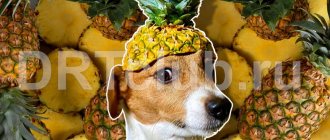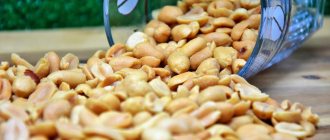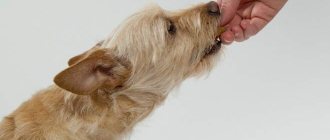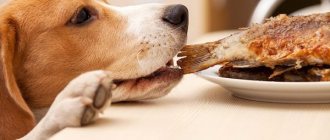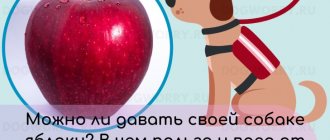Can dogs be given grapes? The answer is no! Eating a small amount of these berries causes diarrhea and vomiting in the animal; in large quantities, it can lead to the death of the pet. Why dogs eat forbidden fruit with pleasure, and what harm grapes can cause – we’ll talk about this later.
Feeding dogs grapes - how good is this idea?
Shushan Meloyan / unsplash.com
Grapes are juicy sweet or sweet and sour berries that we eat as a light snack and are liked by almost all people. Grapes are also good as a food item - they are low in calories and rich in nutrients such as potassium and fiber.
However, research scientists and veterinarians know that grapes and grape products are poisonous to dogs.
Although this information has been publicly available for more than 20 years, the exact cause of toxicity remains unknown.
But why can humans eat grapes safely, but dogs cannot? How do you know if your dog has suffered from grape toxicity, and what can you do about it? Here's what experts want to convey to the general public on the question of whether dogs can eat grapes, as well as the toxicity of grapes to dogs.
About the beneficial and harmful properties of grapes
This statement will surprise many, because doctors everywhere talk about the benefits of grapes. It has a beneficial effect on the entire human body: fiber improves digestion, and microelements, including potassium, calcium, phosphorus, magnesium, sodium, iron, on the nervous system. The berries contain one of the plant estrogens - resveratrol, which helps reduce cholesterol levels in the blood and relieve vascular inflammation.
Phenolic compounds - caffeic acid, myrcetin and quercetin - protect the body from the development of cancer cells, and the seeds contain natural oils and vitamins - A, E, K and others. In total, grapes contain more than 300 compounds that have beneficial properties for the body:
- bactericidal;
- tonic;
- antioxidant;
- radioprotective;
- neurostimulating.
For humans, grapes are a whole storehouse of useful substances, then why are veterinarians so categorical in their statement that dogs should not eat grapes?
Can dogs eat grapes?
Ergita Sela / unsplash.com
Experts say you should never feed your dog grapes or grape products!
Because they contain toxins that can cause serious health problems in dogs. “Grapes and raisins can cause life-threatening kidney disease in some dogs,” says Angela Witzel Rollins, DVM, PhD, professor of veterinary nutrition at the University of Tennessee. She says you should always avoid feeding grapes and grape products to dogs. Experts add that raisins, which are dried grapes, are also toxic to dogs. see also
8 Foods You Shouldn't Give Your Dog: Expert Opinion
Harm
Veterinarians and zoologists do not have a consensus on the question of whether it is harmful for dogs to eat tangerines. Some experts claim that citric acid, which is contained in fruits, depresses the nervous system, which negatively affects the psycho-emotional state of the animal. Excess citric acid often causes problems with the gastric mucosa and causes digestive disorders.
A large group of veterinarians believes that lemon juice is beneficial to animals, but sucrose is harmful to them. This component often causes stomach upsets, other digestive problems and allergic reactions.
It is important! It is believed that large amounts of vitamin C are harmful to the body. In fact, excess is quickly and without consequences eliminated by the kidneys and liver - provided that these organs are healthy and can cope with the load. However, one-time consumption of large quantities of citrus fruits is fraught with overdose.
Why are grapes toxic to dogs?
Michelle Tresemer / unsplash.com
Again, the American Kennel Club (AKC) states that researchers still don't know exactly what toxin or toxic substance in grapes is harmful to dogs. However, experts say some studies indicate that grapes are likely toxic to dogs because they contain tartaric acid.
“Grapes contain a compound called tartaric acid,” says Tina Wismer, DVM, senior director of the American Society for the Prevention of Cruelty to Animals (ASPCA) Animal Poison Control Center. “It is an organic acid, and dogs are the only species that cannot quickly eliminate this compound from their bodies. It is believed that it will remain in the kidney cells for some time and can damage them.”
Healthy treats for dogs: recipes for treats for pets
You want to keep your dog healthy, but how can you give up reward training? The trap of all training is the intake of calories, which we do not take into account when preparing a diet.
One way to avoid extra calories during training is to feed a specific amount of food, no more, no less. That is, you must measure the treat in grams. Or take a look at the following options:
- Asparagus: Simply chop up some raw asparagus and place it in a plastic bag. This treat is rich in vitamins, iron, copper, potassium and folate.
- Blueberries: No need to chop anything. Each berry contains large amounts of antioxidants.
- Green beans: a hearty and crunchy treat. In addition, it contains useful omega-3, vitamins A, C, K
- Watermelon: Fruit cubes are a refreshing treat containing vitamins B6 and C, as well as anti-cancer enzymes.
How many grapes does a dog need to eat for them to be dangerous?
Matthew Henry / unsplash.com
Grapes and their products are always dangerous for dogs, regardless of the amount consumed, and regardless of the breed of animal, their gender or age. But a dog's size and weight can make a difference in how dangerous it is for him to eat grapes. "More than one grape per 10 pounds of dog weight is potentially dangerous," Wismer says. The AKC states that eating even one grape or raisin can be fatal to a dog.
What to replace it with?
There are currently many preventative medications designed specifically for dogs. They can replenish supplies of necessary elements without harm to health. The vitamins in them are presented in the most suitable form.
For example, the drug Ester-S has become widespread among dog handlers around the world, thanks to the good results noticeable on different dogs in a short time.
An alternative replacement for citrus fruits can be the use of less aggressive fruits and berries (with less acid content), but still useful in terms of the amount of vitamins. These fruits include:
Can dogs eat grape seed extract?
www.pinterest.com.mx
Some research in the Canadian Journal of Veterinary Research suggests that grape seed extract may be safe or even beneficial for dogs, primarily by acting as an antioxidant. Antioxidants protect healthy cells from damage and destruction.
see also
How to choose and store grapes correctly (plus several recipes)
Researchers studied 11 therapeutically healthy dogs and gave half of them an antioxidant supplement containing grape seed extract and other ingredients. Dogs taking the supplement had lower triglycerides and oxidative stress markers.
But another study, published in the EFSA Journal, found that it is not entirely clear whether grape seed extract is safe for dogs to consume. Experts have concluded that the safest choice for dogs and their owners is to stay away from grape seeds. At least until more information becomes available about their potential toxicity to dogs.
“My puppy eats and everything is fine...”
On forums you can see many messages about a dog eating grapes and everything is fine. Entire theories have been put forward about the fact that you can give grapes “from the bush” - they are your own, domestic and safe, many dogs, according to the assurances of their owners, have been eating grapes for several years and everything is fine.
In general, there are many myths about the safety of grapes . Their creation was greatly facilitated by the fact that the nutritional composition of different grape varieties is very different and some of them may indeed be harmless to animals, but which ones have not yet been established.
It is important to remember two things: first, each animal's body is unique . Each has its own characteristics, its own diseases and threshold for assimilating toxic substances.
Secondly, the dog's health depends entirely on you . According to statistics, in most cases this berry turns out to be poisonous, so is it worth the risk?
Fresh and dried, grown on a farm or even with your own hands, bought in a store, seedless grapes (you remember that it’s not about the seeds), white and dark - all can equally turn out to be a lethal treat for a pet , leading to kidney failure .
Also, frequent consumption of grapes, even if everything went well the first time, can have a cumulative negative effect . In this case, the consequences of poisoning will appear in a couple of months. All of the above also applies to raisins: these are the same grapes, and the concentration of the substance in them is increased.
IMPORTANT: According to veterinarians, there are no substances in grapes that are beneficial for dogs. If an animal asks for it, this indicates exclusively a love for sweets. But choosing a safe analogue of sweets will not be difficult.
What happens if a dog eats grapes?
Chris Arthur-Collins / unsplash.com
According to the AKC, symptoms of grape poisoning often develop within a few hours of a dog eating grapes. “The first symptoms of grape consumption include vomiting and lethargy, followed by increased thirst and urination until the kidneys shut down,” says Wismer. Here's another expert opinion from another specialist. Jennifer A. Larsen, DVM, MS, PhD, professor of clinical nutrition at the University of California, Davis Veterinary Medical Teaching Hospital, adds that grape toxicity can also cause neurological disease in dogs.
Signs of grape poisoning in dogs include:
- decreased appetite;
- unusual weakness, lethargy, or immobility;
- diarrhea and vomiting;
- abdominal pain, painful to the touch;
- decreased or increased urination;
- strong or increased thirst;
- dehydration (shortness of breath, pale gums, dry mouth and nose, skin does not return to its original position when stretched);
- labored breathing;
- loss of consciousness.
The animal still ate a dangerous berry - symptoms
It can be difficult to prohibit a dog from doing anything, so it is impossible to completely exclude options in which the animal gets to poisonous berries. It is important to detect poisoning in time: the dog can be cured only before the onset of acute renal failure; later, all that the veterinarian will offer you is humane euthanasia.
Symptoms appear anywhere from a few hours to 4 days after an unwanted treat:
- Lethargy, weakness and apathy. If the animal refuses to walk and play, be wary.
- Nausea, abdominal pain (to identify the problem, touch the stomach and look at the animal’s reaction).
- Nausea is followed by vomiting . It begins within 24 hours after eating grapes and raisins, and can last for several hours. This is a clear sign of poisoning. Take a closer look at the vomit: if it contains half-digested grapes, go to the vet immediately.
- Loss of appetite.
- Diarrhea. Grapes may also be found in the stool.
- Loss of coordination ( ataxia ).
- Dehydration.
- A decrease in the volume of urine, and then its complete absence . This is an extremely dangerous symptom!
What to do in case of poisoning?
Do not panic. If you go to the clinic within the first 20 hours, the chances of survival are one hundred percent.
You need:
- Induce vomiting.
- Give the animal plenty of water to drink.
- If possible, give activated carbon (it is better to calculate it relative to the weight of the animal by calling your veterinarian). It absorbs toxins.
- Take the animal to the veterinarian and tell him what he ate.
Further treatment depends on the clinic, but you will need to ensure that the dog is examined in the following ways :
- Palpation of the abdominal cavity;
- a detailed blood test (it will immediately become clear what condition the kidneys and liver are in);
- Ultrasound examination of the kidneys and abdominal organs.
After this, if the diagnosis is confirmed, the animal will be left in the clinic under observation . The dog will receive saline drips and medications to stimulate urine output and production. Drugs are often needed to support the kidneys and liver, but this depends on the severity of the poisoning.
If everything goes well, after two days the pet can be taken home. Within a month he will need a diet - the same as for animals with diseased kidneys. You should not introduce new foods into your diet, especially healthy ones, such as cheese and sweets.
What to do if your dog ate grapes
James Barker / unsplash.com
If you suspect your dog has eaten grapes or grape products, contact your veterinarian or emergency veterinary clinic near you. Try to gather as much information as possible about what your dog ate, how much and when.
see also
A formula has been developed to calculate the age of dogs in human years.
This valuable information can help determine the best course of treatment for your dog. “The actual amount of grapes ingested is critical in determining treatment,” Wismer notes. When seeking emergency care for your dog, experts say you need to have all the animal's information at hand, such as the dog's weight and other health data.
A veterinarian, veterinary technician, or toxicologist may advise you to try to get your dog to vomit as soon as possible if he does not:
- already vomited;
- has trouble breathing or swallowing;
- suffocates;
- very lethargic or weak;
- unconscious;
- she has seizures or hyperactive behavior.
Never make your dog vomit if he has ingested sharp or caustic substances or medications, or if he has recently had abdominal surgery or has a swollen or enlarged esophagus. Don't even try to induce vomiting in your dog unless directed by a professional veterinarian.
Questions and answers
Our readers often ask questions that they want answered. Therefore, we present the most common of them.
Can dogs eat seedless grapes?
Regardless of the presence or absence of a seed in a grape, it should not be given to a dog. In addition, it is prohibited to feed your pet any baked goods containing raisins.
Can dogs eat green grapes?
Only an owner who does not love his devoted friend will feed his pet green unripe grapes. Not only is the fruit unripe and sour, but your pet can get poisoned from a small amount.
Can dogs eat grape leaves?
If your pet eats grape leaves, it means he has problems with the gastrointestinal tract. There is no point in stopping him from doing this. Dogs can eat leaves. The rough, hard leaves cleanse the stomach, causing the animal to vomit.
How to avoid poisoning?
The dog loves sweets, which is why it is attracted to delicious juicy grapes. Her desire can be satisfied with other, safer fruits. For example, a piece of pear with less sucrose, green apples, kiwi, banana, watermelon or cantaloupe. You can also give your dog raspberries, strawberries, gooseberries or currants.
My dog eats grapes without harming his health!
Such statements are quite common on animal lovers forums. However, you should not listen to their opinion. Each animal, like a person, is individual and has its own immunity. What may be a minimal amount for other dogs may be the maximum toxic dosage for your dog.
In conclusion, I would like to repeat: giving grapes to dogs is strictly prohibited. What is healthy and tasty for humans can cause serious harm to an animal’s body. A small amount of berries provoke disruption of the gastrointestinal tract and cause kidney failure. Take care of your pets.
How to make a dog vomit
To induce vomiting in a dog, try sticking your finger down its throat or giving it a small amount of food if it hasn't eaten for at least two hours, experts say.
According to the AKC, if your dog has eaten grapes within the last two hours, you can also administer orally (pour into the mouth) one teaspoon of 3 percent hydrogen peroxide solution for every 6 pounds of body weight to induce vomiting (maximum dose is three tablespoons for dogs weighing 20 kg). Hydrogen peroxide irritates your dog's intestines. Typically, it induces vomiting within 10-15 minutes of administration. Vomiting can last up to 45 minutes, removing about 50 percent of what your dog has ingested.
To administer hydrogen peroxide to your dog orally, use a feeding syringe or turkey baster. Inject the solution into the back of the dog's mouth or tongue, or between the back teeth, and do not allow the animal to inhale the solution. If the dog does not vomit within 15 minutes of being given the hydrogen peroxide solution, a second dose can be given.
The AKC recommends monitoring your dog after attempting to induce vomiting and collecting all vomit so a veterinarian can examine it. Also monitor your dog for additional symptoms or adverse events or reactions, including diarrhea, increased lethargy, bloating, or vomiting lasting more than 45 minutes.
Nature is smarter than dog training manuals
Where do dog diet guidelines come from? That's right, from canine manuals, supported by the experience of “experienced dog lovers”, and even our own. In fact, people’s opinions, their considerations and guesses, influence the lifestyle of pets and whether this is correct is a moot point. There is an indisputable fact that an animal living in the wild eats only what is good for it. And if this fact is true, the question arises about the benefits of alcohol - it is extracted from fermented fruits by elephants, primates and canines. The harmfulness of intoxicating herbs, which four-legged animals often “indulge,” is also questioned. Naturally, everything is not so simple. The instincts embedded in the genetic code of animals work only for the sake of survival and preservation of the species, which means that a four-legged animal will not eat poison, a priori it will not have such a desire.
Further, it is worth taking into account the fact that with a lack of vitamins, microelements or a metabolic disorder, any animal may have a desire to eat inedible things. The grass is inedible for dogs, but canines regularly feast on fresh wheatgrass to cleanse their stomachs. Chalk is inedible for humans, but many pregnant women are exhausted by the desire to eat it. So, maybe if a dog eats tangerines there is a reason for this?
Treatment of a dog that ate grapes
Chris Benson / unsplash.com
Experts and veterinary organizations say that in many cases, the veterinarian will try to induce vomiting if the dog has recently eaten grapes, which may involve administering an oral hydrogen peroxide solution. If initial attempts to induce vomiting in your dog are unsuccessful, or it has been a long time since your dog ingested grapes or raisins, your veterinarian may give him stronger medications to try to flush out the toxins. Your veterinarian may also give your dog IV fluids to restore his electrolyte balance. The composition also helps to quickly “flush” toxins from the animal’s body.
see also
19 facts about dogs that explain their behavior
What is the danger to the animal?
To this day, the substance that leads to intoxication of the body has not been identified. The assumption that pesticide residues on fruits contribute to poisoning has not been confirmed, since clean, untreated berries have exactly the same nephrotoxic effect.
The version that the source of poisoning is the seeds, which overwhelmingly contain inorganic acids, was also not confirmed. Firstly, the bones are not digested in the dog’s stomach, and secondly, seedless varieties, for example, sultanas, act in the same way as seed varieties.
Scientists are inclined to believe that it is not a specific element of grapes that leads to intoxication if it is fed to a pet, but a combination in high concentrations. It has been established that the fruit contains many vitamins, macro- and microelements, so a sharp increase in their levels in the dog’s body can lead to vomiting.
Attention! In this case, the digestive system is the first to be affected: vomiting of the remains of undigested fruit occurs, and this is all accompanied by severe diarrhea.
The animal’s kidneys try to neutralize toxins, but as a result, autointoxication syndrome develops, which leads to the accumulation of metabolic products in the blood and, consequently, blocking the functioning of metabolic processes.
Some owners, knowing how grapes act on their pets’ bodies, wonder if dogs can have raisins? It should be noted that a derivative of this berry, raisins, is many times more dangerous for animals; one might say, it is poison for them. For representatives of medium-sized breeds, it is enough to eat a dozen fresh grapes to become poisoned, while only 3-4 pieces of raisins are enough.
Many owners are also interested in whether the puppy can be given grapes. The unequivocal answer is no, because if such an amount of the product is destructive for medium-sized breeds, then the puppy should not eat such berries at all.
Important! Grape juice is enriched with vitamins necessary for humans for proper development; however, it is also not recommended for dogs to consume it.
If signs of poisoning are detected, first aid must be provided and immediately go to the veterinarian
Other foods that are dangerous for dogs
Christian Bowen / unsplash.com
Some products contain ingredients that can be harmful to dogs because they are toxic to them and poisoning is difficult to treat. These foods are difficult to digest and can pose a choking hazard or become stuck in the digestive tract and cause a blockage (intestinal obstruction).
Here are some foods that experts say should not be given to dogs:
- chocolate;
- ice cream;
- most spices and seasonings;
- most nuts, including almonds, macadamia nuts, pecans and walnuts;
- onions and leeks;
- garlic;
- bread yeast;
- tomatoes;
- mushrooms;
- alcohol;
- caffeine;
- citrus;
- coconut;
- undercooked or raw meat, bones or eggs;
- artificial sweeteners such as xylitol;
- salty or sweet snacks and foods;
- apple and mustard seeds;
- fruit pits, seeds, pits and peels;
- gum;
- hop;
- moldy food;
- rhubarb leaves.
Problems due to processing
Exotic fruits that are exported are picked unripe and then treated with special substances to preserve their freshness. Most often used for these purposes:
- Diphenyl is a solution containing insoluble crystals and organic solvents. The drug is colorless, tasteless and odorless; you cannot see it visually. Biphenyl protects fruit from mold, but it is toxic.
- Gases – they vary depending on the exporting state. Gas treatment protects citrus fruits from rotting and mold, and stimulates the ripening process during transportation.
According to regulations, toxic components must remain on the peel. In fact, the risk of stomach upset remains whether dogs eat tangerines with or without the peel. The longer citrus fruits are in transit, the more they become saturated with toxic substances.
The only absolute contraindication is an allergic reaction or individual intolerance to tangerines.
Safe food to feed dogs
Karsten Winegeart / unsplash.com
While some foods can pose health risks for dogs, there are many foods that are safe for you and also safe for dogs (which is even better!). And experts say giving your dog the occasional treat from your diet will help add variety to your dog's diet, create excitement and interest, and also have nutritional benefits.
see also
16 facts about dogs that explain many of their strange behavior
Veterinarians and the AKC suggest several common foods you can feed your dog, but in moderation:
- strawberries, blueberries, cranberries and raspberries;
- watermelon and melon;
- yogurt and milk (in very small quantities);
- bread and wheat, grain products;
- cooked turkey, chicken and ham;
- boiled eggs;
- salmon, shrimp, tuna, most other fish and seafood;
- popcorn;
- unflavored, out-of-season peanuts;
- peanut butter;
- honey;
- eggs;
- corn;
- cheese;
- quinoa and most legumes (cooked);
- potatoes (boiled and peeled);
- a pineapple;
- carrot;
- broccoli and cauliflower;
- kiwi;
- cucumbers;
- green bean;
- canned or boiled pumpkin;
- celery.
As a precaution, experts say you should always remove the peel, husk, stems, leaves, thorns, seeds and pits from fruits and vegetables before feeding them to dogs. Some vegetables also need to be cooked before being given to dogs to ensure they are safe - such as potatoes. As a general rule, if you need to cook some food before eating it, it should also be cooked before feeding it to your dog.
What vegetables and fruits can be given to dogs?
Leave handfuls of grapes for your lunch, and choose an alternative option for your pet.
Dogs need vitamins and minerals every day too! They are carnivores: their diet should include meat, vegetables and fruits. Your pet should get plenty of fresh greens and fruits, but first make sure they are safe for your friend.
Foods approved for dogs : Apples, Apricots (boneless), Asparagus, Bananas, Broccoli, Blueberries, Carrots, Green beans, Peas, Pumpkin, Raspberries, Spinach, Watermelon
Rules for natural nutrition
Regarding feeding the Pomeranian Spitz with natural food, there are general recommendations:
- Provide your dog with access to clean drinking water. Change it daily.
- Do not mix natural food and dry food. Choose one diet or give food at different times.
- If you decide to change your diet, you can’t do it right away. The shift period should take 2-3 weeks.
- Give only fresh food. If your pet doesn't eat enough food within 15 minutes, don't let him eat until the next meal.
- Determine the amount of food based on your pet's weight.
- The diet should be balanced. If you decide to feed your dog, consult your veterinarian for recommendations.
Dogs should not be given sweets
The main natural diet of a Spitz should be meat. Choose low-fat varieties: veal, chicken, turkey, rabbit. The daily intake of meat should be 50-60% of the total food volume.
Spitz can be given meat raw or lightly scalded, but only after preliminary freezing. Replace meat with offal two to three times a week.
Attention ! Puppies can be given offal no earlier than 3 months of age.
Offal products that are an excellent addition to a natural diet include:
- scar;
- liver;
- lungs;
- kidneys;
- trachea.
By-products
You can also give dogs low-fat sea fish, but not earlier than four months of age. This product should be given deboned, no more than once a week, completely replacing meat with fish.
Sour dairy products must be present in the diet. Their norm is no more than 30% of the daily food intake. For up to six months, your Spitz should be given cottage cheese every day. It is rich in calcium, which allows the formation of a healthy bone skeleton and cartilage tissue.
The Japanese Spitz is a snow-white beauty.
Add fermented milk to your diet about five times throughout the week.
The carbohydrate component is porridge, but not more than 15% of the total daily diet. You can feed buckwheat, rice, and oatmeal cooked in water or low-fat broth (no more than 2-3 times a week).
Suitable cereals for feeding
Egg yolks are responsible for the fat component. You can give quail eggs, but no more than 1-2 times a week in the amount of two or three pieces.
Feed your dog only after a walk. You can’t actively run on a full stomach; you may end up with a volvulus.
In hot weather, feed your dog once a day. During cold weather, distribute food evenly.
Find out how a female dog is in heat.
Pregnant and lactating bitches should not be hungry, so the food bowl does not need to be removed immediately after eating.
